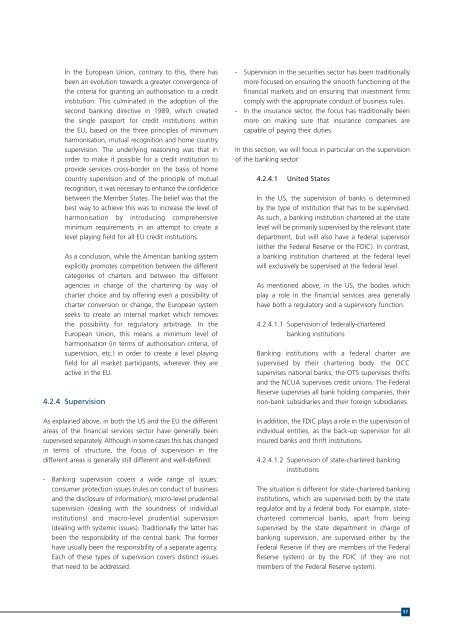A comparative analysis of the US and EU retail banking markets - Wsbi
A comparative analysis of the US and EU retail banking markets - Wsbi
A comparative analysis of the US and EU retail banking markets - Wsbi
Create successful ePaper yourself
Turn your PDF publications into a flip-book with our unique Google optimized e-Paper software.
In <strong>the</strong> European Union, contrary to this, <strong>the</strong>re has<br />
been an evolution towards a greater convergence <strong>of</strong><br />
<strong>the</strong> criteria for granting an authorisation to a credit<br />
institution. This culminated in <strong>the</strong> adoption <strong>of</strong> <strong>the</strong><br />
second <strong>banking</strong> directive in 1989, which created<br />
<strong>the</strong> single passport for credit institutions within<br />
<strong>the</strong> <strong>EU</strong>, based on <strong>the</strong> three principles <strong>of</strong> minimum<br />
harmonisation, mutual recognition <strong>and</strong> home country<br />
supervision. The underlying reasoning was that in<br />
order to make it possible for a credit institution to<br />
provide services cross-border on <strong>the</strong> basis <strong>of</strong> home<br />
country supervision <strong>and</strong> <strong>of</strong> <strong>the</strong> principle <strong>of</strong> mutual<br />
recognition, it was necessary to enhance <strong>the</strong> confidence<br />
between <strong>the</strong> Member States. The belief was that <strong>the</strong><br />
best way to achieve this was to increase <strong>the</strong> level <strong>of</strong><br />
harmonisation by introducing comprehensive<br />
minimum requirements in an attempt to create a<br />
level playing field for all <strong>EU</strong> credit institutions.<br />
As a conclusion, while <strong>the</strong> American <strong>banking</strong> system<br />
explicitly promotes competition between <strong>the</strong> different<br />
categories <strong>of</strong> charters <strong>and</strong> between <strong>the</strong> different<br />
agencies in charge <strong>of</strong> <strong>the</strong> chartering by way <strong>of</strong><br />
charter choice <strong>and</strong> by <strong>of</strong>fering even a possibility <strong>of</strong><br />
charter conversion or change, <strong>the</strong> European system<br />
seeks to create an internal market which removes<br />
<strong>the</strong> possibility for regulatory arbitrage. In <strong>the</strong><br />
European Union, this means a minimum level <strong>of</strong><br />
harmonisation (in terms <strong>of</strong> authorisation criteria, <strong>of</strong><br />
supervision, etc.) in order to create a level playing<br />
field for all market participants, wherever <strong>the</strong>y are<br />
active in <strong>the</strong> <strong>EU</strong>.<br />
4.2.4 Supervision<br />
As explained above, in both <strong>the</strong> <strong>US</strong> <strong>and</strong> <strong>the</strong> <strong>EU</strong> <strong>the</strong> different<br />
areas <strong>of</strong> <strong>the</strong> financial services sector have generally been<br />
supervised separately. Although in some cases this has changed<br />
in terms <strong>of</strong> structure, <strong>the</strong> focus <strong>of</strong> supervision in <strong>the</strong><br />
different areas is generally still different <strong>and</strong> well-defined:<br />
- Banking supervision covers a wide range <strong>of</strong> issues:<br />
consumer protection issues (rules on conduct <strong>of</strong> business<br />
<strong>and</strong> <strong>the</strong> disclosure <strong>of</strong> information), micro-level prudential<br />
supervision (dealing with <strong>the</strong> soundness <strong>of</strong> individual<br />
institutions) <strong>and</strong> macro-level prudential supervision<br />
(dealing with systemic issues). Traditionally <strong>the</strong> latter has<br />
been <strong>the</strong> responsibility <strong>of</strong> <strong>the</strong> central bank. The former<br />
have usually been <strong>the</strong> responsibility <strong>of</strong> a separate agency.<br />
Each <strong>of</strong> <strong>the</strong>se types <strong>of</strong> supervision covers distinct issues<br />
that need to be addressed.<br />
- Supervision in <strong>the</strong> securities sector has been traditionally<br />
more focused on ensuring <strong>the</strong> smooth functioning <strong>of</strong> <strong>the</strong><br />
financial <strong>markets</strong> <strong>and</strong> on ensuring that investment firms<br />
comply with <strong>the</strong> appropriate conduct <strong>of</strong> business rules.<br />
- In <strong>the</strong> insurance sector, <strong>the</strong> focus has traditionally been<br />
more on making sure that insurance companies are<br />
capable <strong>of</strong> paying <strong>the</strong>ir duties.<br />
In this section, we will focus in particular on <strong>the</strong> supervision<br />
<strong>of</strong> <strong>the</strong> <strong>banking</strong> sector.<br />
4.2.4.1 United States<br />
In <strong>the</strong> <strong>US</strong>, <strong>the</strong> supervision <strong>of</strong> banks is determined<br />
by <strong>the</strong> type <strong>of</strong> institution that has to be supervised.<br />
As such, a <strong>banking</strong> institution chartered at <strong>the</strong> state<br />
level will be primarily supervised by <strong>the</strong> relevant state<br />
department, but will also have a federal supervisor<br />
(ei<strong>the</strong>r <strong>the</strong> Federal Reserve or <strong>the</strong> FDIC). In contrast,<br />
a <strong>banking</strong> institution chartered at <strong>the</strong> federal level<br />
will exclusively be supervised at <strong>the</strong> federal level.<br />
As mentioned above, in <strong>the</strong> <strong>US</strong>, <strong>the</strong> bodies which<br />
play a role in <strong>the</strong> financial services area generally<br />
have both a regulatory <strong>and</strong> a supervisory function.<br />
4.2.4.1.1 Supervision <strong>of</strong> federally-chartered<br />
<strong>banking</strong> institutions<br />
Banking institutions with a federal charter are<br />
supervised by <strong>the</strong>ir chartering body: <strong>the</strong> OCC<br />
supervises national banks, <strong>the</strong> OTS supervises thrifts<br />
<strong>and</strong> <strong>the</strong> NCUA supervises credit unions. The Federal<br />
Reserve supervises all bank holding companies, <strong>the</strong>ir<br />
non-bank subsidiaries <strong>and</strong> <strong>the</strong>ir foreign subsidiaries.<br />
In addition, <strong>the</strong> FDIC plays a role in <strong>the</strong> supervision <strong>of</strong><br />
individual entities, as <strong>the</strong> back-up supervisor for all<br />
insured banks <strong>and</strong> thrift institutions.<br />
4.2.4.1.2 Supervision <strong>of</strong> state-chartered <strong>banking</strong><br />
institutions<br />
The situation is different for state-chartered <strong>banking</strong><br />
institutions, which are supervised both by <strong>the</strong> state<br />
regulator <strong>and</strong> by a federal body. For example, statechartered<br />
commercial banks, apart from being<br />
supervised by <strong>the</strong> state department in charge <strong>of</strong><br />
<strong>banking</strong> supervision, are supervised ei<strong>the</strong>r by <strong>the</strong><br />
Federal Reserve (if <strong>the</strong>y are members <strong>of</strong> <strong>the</strong> Federal<br />
Reserve system) or by <strong>the</strong> FDIC (if <strong>the</strong>y are not<br />
members <strong>of</strong> <strong>the</strong> Federal Reserve system).<br />
57
















